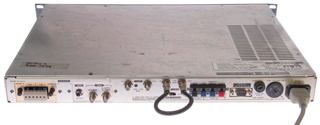
In Oct 2014 there are a number of various versions of this receiver (1724, 2210, 2237, 1240, 1824, 1624, 240, 324, 424, on eBay for reasonable prices. It may be useful in relation to my Ku-band Free To Air TV receive only system (still not fully setup).
This is a 1 Unit high 19" Rack Panel format satellite television receiver (Wiki). These are typically used as cable TV head end equipment rather than as home satellite TV receivers. There would be one of these for each channel offered by the cable provider where the source was from a satellite, i.e. for all the channels except for off the air or locally produced channels. For a large cable provider that would be hundreds of these receivers.
The first generation satellite TV receive only terminals (Wiki: TVRO) were used by at the head end of cable television systems and operated on 24 channels of C-band (3.7 - 4.2 Ghz) channels with 40 MHz channel spacing and 40 MHz channel bandwidth. There are also terrestrial signals in the same band but offset 10 MHz, for example at 3.71, 3.73... GHz. These systems typically used large (10' to 18' diameter circular outline parabolic dishes with a central feed. The signal was analog. Both Vertical and Horizontal polarization (Wiki) were used alternating between adjacent satellites to allow twice as many C-band satellites to fit into the 360 degrees of available geostationary orbit (Wiki) space.
The next generation Direct Broadcast satellite television (Wiki) operates in Ku-band (11.7 - 12.2 GHz). Notice that the RF bandwidth (500 MHz) is the same as for a C-band system. The Ku-band system uses the same C-band up-link (Wiki) frequency and modulation as the old C-band system. So both systems have the same number of channels.
The antenna used with this receiver would have a feed with either Horizontal, Vertical, right hand circular or left hand circular polarization and a Low Noise Block (Wiki) converter.
This receiver has two LNB inputs in the frequency range 950 to 1450 MHz which matches the LNB output from both C-band and Ku-band LNBs. These two inputs can be either for V and H polarization, or C and Ku band frequencies.
Photos
Photos 1 & 2 poorer versions of Fig 3 so removed.
Fig 3 Front Panel with power applied and LCD showing data

Fig 4 Rear Panel

Fig 5 Inside Top
Menus
When powered up the LCD shows "CHAN 18 4.060"
Pressing TUNE/SELECT Up or Down changes the channel number by +1 or -1 and the channel frequency by +0.02 or -0.02.
The possible channels range from chan 1 3.720 to chan 24 4.180.
In the tables below the left column is what I see without changing any settings. The columns to the right show the programming options.
Repeatedly pressing TUNER results in the LCD showing (in order):
CHAN 18 4.060
POLARITY V
FINE TUNE 0
IF 22 T EXT OFF
CHAN 18 4.060
Repeatedly pressing DEMOD1 results in the LCD showing (in order):
CHAN 18 4.060
DEMOD #1
VIDEO
GAIN 16.5 MHz/V
VIDEO LEVEL 0.0
DE-EMP 525
VIDEO NORMAL
CHAN 18 4.060
Repeatedly pressing DEMOD2 results in the LCD showing (in order):
CHAN 18 4.060
DEMOD #2
DUAL AUDIO
CHANNEL A
FREQ/A 6.20 MHz
AUD BW/A 230/400
DE-EMP /A J17
DNR(TM) OFF
CHAN 18 4.060
Free To Air Satellite TV Systems
Satellite TV 4-Way power Splitter used for multiple GPS receivers
Starband VSat 2-way satellite internet connection
AT&T 2Wire DSL modem
Home Theater TV system